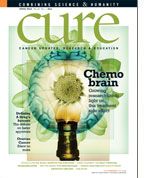Publication
Article
CURE
Fighting Back
Author(s):
Neutropenia means losing protection from infection.
When your body gets sick, your immune system tries to fight the infection, similar to a battlefield where germs are the invaders. Soldiers against the illness are white blood cells called neutrophils. When you don’t have enough neutrophils, your body’s defenses are compromised, making it harder to fight infection—a condition called neutropenia.
Neutropenia is determined by an absolute neutrophil count (ANC). The ANC is calculated by multiplying the percentage of neutrophils by the total number of white blood cells. Around 50 to 70 percent of all white blood cells are neutrophils, so having 1,500 or more neutrophils for every microliter of blood is considered normal, and this level is typically required for the administration of any chemotherapy. An ANC below 1,000 is considered to be neutropenia, and 500 or below is considered severe. A low white count on its own usually has no symptoms. The lower the ANC and the longer it stays that way, the greater the risk of infection.
Sometimes a fever might be your only sign of infection. Other symptoms include fatigue, body aches, swelling and redness, which can also be side effects of chemotherapy. An indicator of an infection is if your ANC is low and you have a fever of 100.5° or higher, a condition called febrile neutropenia, which requires immediate medical attention.
Causes > Traditional cytotoxic chemotherapies target not only cancer cells but also healthy cells and bone marrow. Fast-growing neutrophils (life span is about three to five days) are casualties of the chemotherapy—they are killed off faster than they are replenished. It can take white blood cells three weeks to grow back post-chemotherapy. Studies have indicated that neutropenia often occurs in the early cycles of chemotherapy. Chemotherapy can also affect the red blood cell and platelet counts (and cause anemia and thrombocytopenia, respectively).
Radiation, especially to the pelvis and the spine, can also cause neutropenia. However, hormonal and targeted therapies, as well as certain chemotherapies, such as bleomycin, Xeloda (capecitabine), 5-fluorouracil and vincristine, and the steroid, prednisone, don’t cause neutropenia, but these are typically used in combination with cytotoxic treatments.
Patients with lymphoma and leukemia generally require more aggressive treatments, so their odds for neutropenia also increase. Other risk factors include being elderly, having received prior radiation therapy to the bone, being immunocompromised or diabetic, or having poor liver function, which can increase the toxicity of certain drugs. Other causes for neutropenia include disorders that affect bone marrow function and severe infections.
While undergoing chemotherapy, you will be monitored for infections. Blood counts are checked and reviewed prior to receiving the green light for the next chemotherapy course. In some cases, treatment will be held, delayed or the dose will be adjusted depending on your counts. If infection isn’t caught early, you could experience serious consequences, including treatment delay or disruption, hospitalization and even death.
Prevention > Infections are usually caused by bacteria, fungi or viruses that are typically found on your skin or in the gastrointestinal tract. If you become neutropenic, take precautions to prevent infections. Keep your skin clean by washing your hands, and practice good dental hygiene by keeping your mouth clean with brushing and using an antiseptic mouthwash.
It’s also advisable to avoid eating raw or uncooked foods. Avoid large crowds or people with colds or the flu. Wearing a face mask may be necessary to prevent infection. Granulocyte colony-stimulating factors (G-CSFs) given after chemotherapy and antibiotics can also lower the incidence and severity of infections. Overall, simple measures can help prevent infection if you do develop neutropenia.






